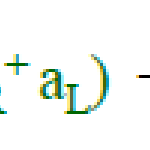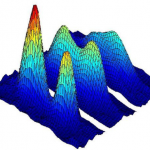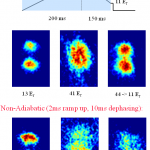MXP
One thing I left out of the making-of story about the squeezed state BEC paper last week happened a while after publication-- a few months to a year later. I don't quite recall when it was-- I vaguely think I was still at Yale, but I could be misremembering. It's kind of amusing, in an exceedingly geeky way, so I'll share it, though it's also a story of an embarrassing mis-step on my part.
So, the physical situation we were studying is described by the "Bose-Hubbard Hamiltonian": Bose because it's dealing with bosons (there's also a Fermi-Hubbard version, I believe); Hubbard after [mumble]…
Yesterday's write-up of my Science paper ended with a vague promise to deal some inside information about the experiment. So, here are some anecdotes that you would need to have been at Yale in 1999-2000 to pick up. We'll stick with the Q&A format for this, because why not?
Why don't we start with some background? How did you get involved in this project, anyway? I finished my Ph.D. work at NIST in early 1999, graduating at the end of May. I needed something to do after that, so I started looking for a post-doc by the don't-try-this-at-home method of emailing a half-dozen people I knew…
In Monday's post on squeezed states, I mentioned that I really liked the question because I had done work on the subject. This is, in fact, my claim to scientific fame (well, before the talking-to-the-dog thing, anyway)-- I'm the first author on a Science paper with more than 500 citations having to do with squeezed states. And since I've never written it up on the blog before, I'll leap on this opportunity to do some shameless self-promotion...
Well, aren't we Mr. Ego today? What's this paper that you're so impressed with about? I've never been all that good with titles, but I like to think…
Last week, in the post about fermion conduction, I left a reference hanging:
There’s nothing physically blocking the atoms from flying right through the channel– in fact, an atom that enters the channel will always exit the other side without slowing down along the way. This is termed “ballistic,” a term that will always have a special place in my heart thanks to an incident at my Ph.D. defense.
Which was what? Let’s just leave that hanging to see if anybody actually reads this far. I can explain it in a comment if people want to know.
A couple of people asked for the explanation in comments…
Via Bee, we have the BlaBlaMeter, a website that purports to "unmask without mercy how much bullshit hides in any text." Like Bee, I couldn't resist throwing it some scientific text, but rather than pulling stuff off the arxiv, I went with the abstracts of the papers I published as a grad student, which I wrote up on the blog as part of the Metastable Xenone Project a few years ago. The abstracts, their scores, and some comments below:
Paper 1: Optical Control of Ultracold Collisions:
Near-resonant light is used to modify the collision dynamics of magneto-optically trapped metastable xenon…
Over the past several weeks, I've written up ResearchBlogging posts on each of the papers I helped write in graduate school. Each paper write-up was accompanied by a "Making of" article, giving a bit more detail about how the experiments came to be, what my role in them was, and whatever funny anecdotes I can think of about the experiment.
If you haven't been following the series, or would just like a convenient index of the posts, here's the complete set:
Introduction and explanation of metastable xenon.
Experiment 1: Optical Control of Ultracold Collisions and the making thereof.…
As mentioned in the previous post, the cold plasma experiment was the last of the metastable xenon papers that I'm an author on. My role in these experiments was pretty limited, as I was wrapping things up and writing my thesis when the experiments were going on.
The main authors on this were Tom Killian, now running his own cold plasma lab at Rice and Scott Bergeson, now running his own cold plasma lab at BYU. Scott was a pulsed-laser expert with a remarkably cavalier attitude toward things like anti-reflection coatings on vacuum windows, and Tom came from Dan Kleppner's hydrogen BEC project…
This is the last of the papers I was an author on while I was in grad school, and in some ways, it's the coolest. It's rare that you get to be one of the first people to do an entirely new class of experiment, but that's what this was. It kicked off a new sub-field (or sub-sub-field...), the history and status of which was written up in Physics a little while back.
The ultracold plasma experiment may be the ultimate version of what we jokingly called the "NIST Paradigm" of cold-atoms physics research, which could be summarized as "I wonder what will happen if we stick this other laser in?" It…
This was the last of the experiments that I did for my thesis (it's not the last xenon paper I'm an author on, but the work for that one was done while I was writing up), so my memories of it are bound up with the thesis-writing process.
My favorite story about this stuff was when I gave a talk about this work at NIST-- I don't recall if it was before or after my defense-- and somebody asked the obvious question about how the quantum statistical rules are enforced. That is, how is it that you never get two identical fermions colliding in an s-wave state? Since an s-wave collision is just a…
This is the last of the five papers that were part of my Ph.D. thesis, and at ten journal pages in length, it's the longest thing I wrote. It was also the longest-running experiment of any of the things I did, with the data being taken over a period of about three years, between and around other experiments. As usual for this series of posts, I can sum up the key result in one graph:
(No spiffy color figure this time, as the experiment never made it onto the old web page, and my original figures are three or four computers ago.)
What we found was that when we prepared samples of metastable…
I said in the previous post that the time-resolved collision paper was one of my favorite experiences in grad school, even the paper-writing process. It's not so much that the paper-writing process was all that exceptionally good-- it was the usual "paper torture," arguing over every single word in an effort to fit everything into Physical Review Letters's four-page limit-- as because the refereeing process was surprisingly good.
We spent a month or so working on the paper, going through several drafts before sending it off. At around the time that we submitted it, the Physical Review…
As I said in the introduction to the previous post, this was the first paper on which I was the lead author, and it may be my favorite paper of my career to date. I had a terrific time with it, and it led to enough good stories that I'm going to split the making-of part into two posts.
The experiment itself was based on an earlier paper by Phil Gould at UConn. Phil was a post-doc at NIST back in the day, and used to visit our group fairly regularly. On one of these visits, he stopped by the xenon lab, and gave me a pre-print of their time-resolved collision paper, saying "You guys really…
This paper is the third of the articles I wrote when I was a grad student, and the first one where I was the lead author. It's also probably my favorite of the lot, not just because of the role it played in my career, but because it packs a lot of science into four pages.
The whole thing is summarized in this figure from the old NIST web page, which is a simplified version of Figure 2 from the paper itself:
This shows the collision rate as a function of time after we hit a cold sample of atoms with a 40ns pulse of laser light tuned near the atomic resonance frequency. As discussed in the…
The experiment described in the previous post was published in early 1998, but the work was done in 1997. This was the year when things really turned around for me in grad school-- the optical control paper was done in the summer 0f '94, and '95 and '96 were just a carnival of pain. Everything in the lab broke, was repaired, and then broke again.
The lead guy on the lattice collision experiment was a post-doc named John Lawall, who really took charge. He completely re-vamped the lock system for the laser, and spent a huge amount of time re-doing the laser alignment for the trap and the…
I announced my intention to do some research blogging a little while ago, and managed one pair of posts before the arrival of SteelyKid kind of distracted me. I'm still planning to complete the Metastable Xenon Project blog, though (despite the utter lack of response to the first two), and the second real paper I was an author on is "Suppression and Enhancement of Collisions in Optical Lattices," a PRL from 1998, with a preprint version available here.
So, this is another paper about collisions, obviously, but what's an optical lattice? An optical lattice is an arrangement of laser beams--…
One of the things I'd like to accomplish with the current series of posts is to give a little insight into what it's like to do science. This should probably seem familiar to those readers who are experimental scientists, but might be new to those who aren't. I think that this is one of the most useful things that science blogs can do-- to help make clear that science is a human activity like anything else, with its ups and downs, good days and bad.
To that end, I'm going to follow the detailed technical explanation of each of these papers with a post relating whatever anecdotes I can think…
(This is the first in a planned series of posts writing up each of the scientific papers on which I am an author. A short description and a link to a PDF of the paper can be found at the archived Optical Control page.)
The essence of the optical control paper is contained in this one figure:
"Very pretty," you're thinking, "But what does it mean?"
The graph shows the increase or decrease in the ionizing collision rate for a sample of xenon atoms (well, two different samples, of different isotopes, but they behave exactly the same) at a temperature of 100 microkelvin or so due to the…
I've been slacking a bit, lately, in terms of putting science-related content on the blog. Up until last week, most of my physics-explaining energy was going into working on the book, and on top of that, I've been a little preoccupied with planning for the arrival of FutureBaby.
I'd like to push things back in the direction of actual science blogging, so I'm going to implement an idea I had a while back: I'm going to go back through the papers in my CV, and write them up for ResearchBlogging.org.
This offers a couple of nice benefits from my perspective. First of all, I already know what's in…


